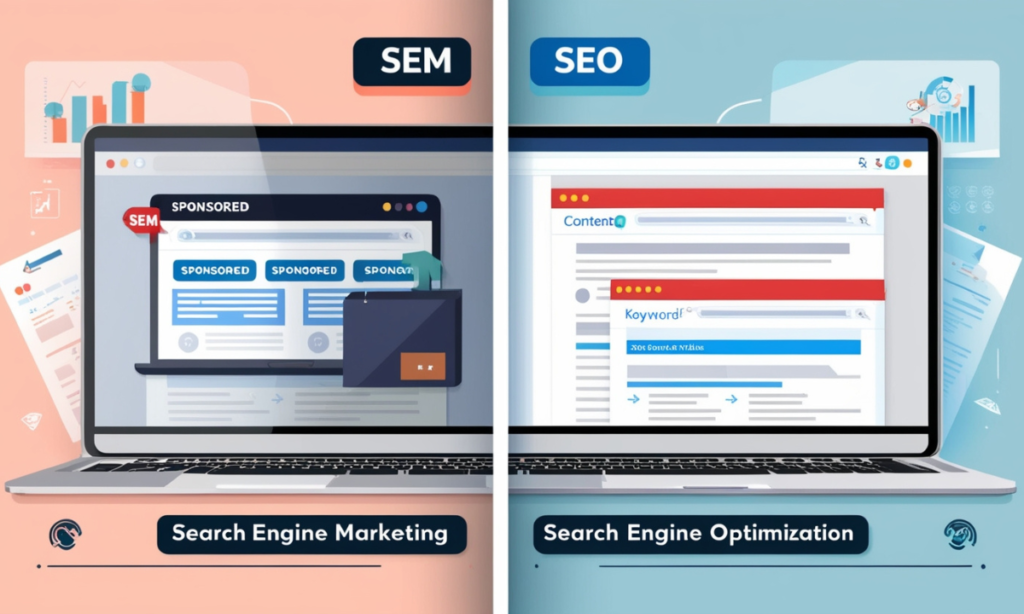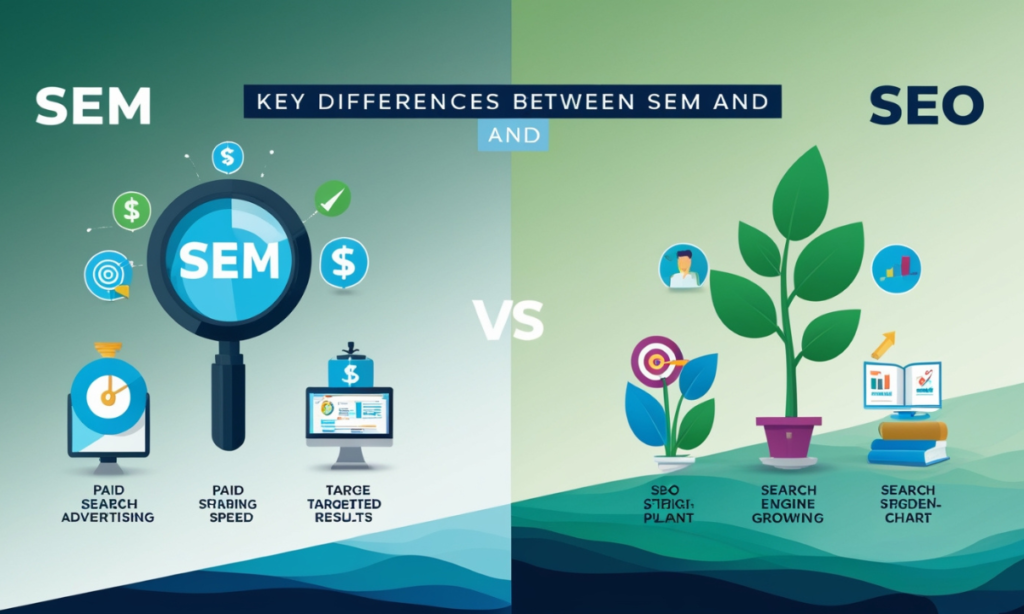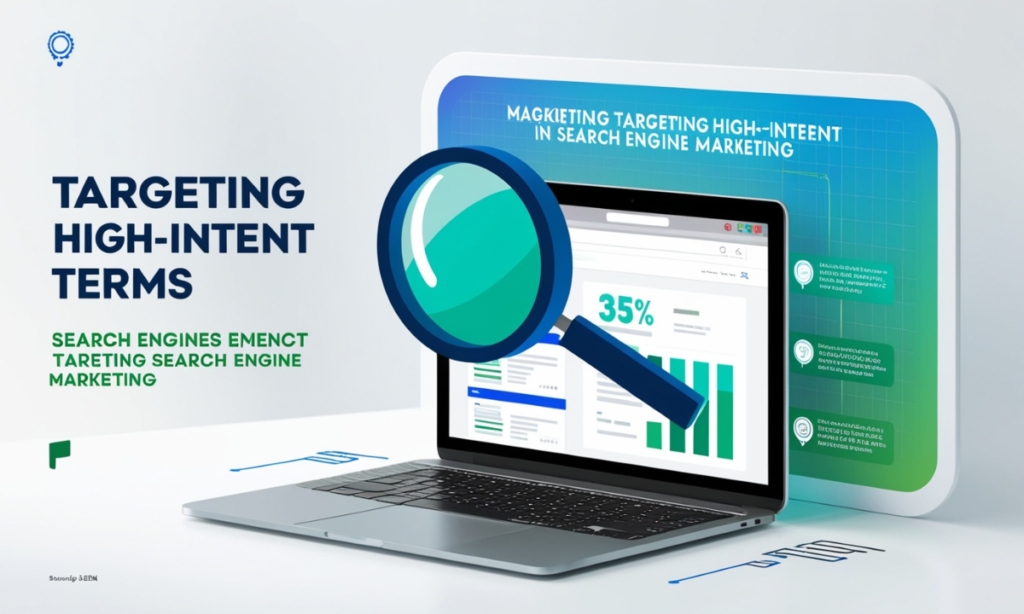What is difference between SEM and SEO,The digital world at present has every business aspiring to enhance its online presence, therefore, Search Engine Marketing (SEM) and Search Engine Optimization (SEO) have become necessary marketing tools for every business that needs to create a strong online presence and attract visitors to its site.
However, despite having such relationships, SEM and SEO are intertwined such that people hardly differentiate them because of their end results and processes.
We may think of these two methodologies in that they both strive to increase the ranking of a website in the search engines, but under different approaches.
What differentiates these approaches is that SEM embraces the use of paid search under immediate results, while SEO relies on the improvement of traffic over a given period of time. In order to make such decisions, it is essential to become familiar with the basic characteristics of each of these strategies.
This article describes what SEM includes how it differs from SEO, what SEO involves, benefits of SEO and SEM where each one of them should be applied to create the best impact.
Key Takeaways
- In SEM, there usually two types of strategies applied, i.e. paid and organic whereas in SEO only organic improvement processes are utilized.
- SEO, in most cases, is low cost, long term, whereas SEM is high cost, short term.
- SEO brings in traffic without cost, while SEM makes use of paid advertisements to get visibility.
- Marketing through search engines enables more accurate targeting of the audience, and SEO fosters brand authority and trust gradually.
- Both SEM and SEO are digital marketing tools that are mostly intertwined with each other’s core efforts.
Understanding Search Engine Marketing (SEM)
SEM, an acronym that refers to Search Engine Marketing, is a subdivision of marketing that deals with promoting internet sites within pay per click search engines. It encompasses a set of strategies that utilize paid advertising in order to achieve immediate exposure and attract relevant website traffic.
SEM in this case means ads displayed on the search engines that capture traffic, which for this example includes Google, Yahoo and Bing using a model referred to as PPC.
The Mechanics of SEM
The key aspect of other SEM is the auction system. If an advertiser is interested in a particular ad, an auction is held for the advertisers wishing to display that specific ad at the top of search results with the highest bidder winning.
But it is not enough to just place the highest bid for a given search term. In order to optimize search experience, search engines utilize a parameter called Quality Score in assessing the performance of ads. Quality scoring ensures that search engine users view only the most appropriate advertisements for the keywords they are searching.
Once the ad goes live, businesses have to incur PPC only on clicking of the ad, hence the term pay per click. This method helps in a speedy and effective way to contact the targeted audience equally, which is why SEM is great for those businesses that want results instantly.
Nevertheless, these are always ad costs that should be maintained. If the money runs out, the ads will stop affecting customers.
Understanding Search Engine Optimization (SEO)
SEO, or Search Engine Optimization, is a type of online marketing consisting of various actions aimed at increasing the organic traffic of a website in search engines. In contrast to SEM, ad space is not purchased in SEO.
In fact, there are a number of optimizations that can be performed in order to help search engines index and rank a given website. Doing SEO is a permanent commitment and takes time to develop fully, but it is a life-breath strategy, especially in the later years.
The Mechanics of SEO
SEO can be segmented into three broad and rather obvious categories: on-page, off-page and technical SEO.
- The term on-page SEO refers to optimizing the factors that are contained on the web pages like the text, images, keywords, and description tags.
- External elements are what the off-page SEO data looks at, more specifically backlinks telling the search engines why the site should be regarded as credible and relevant.
- Technical SEO includes enhancements that are made in the back-end of the site, which may include faster loading time, mobile-friendly websites, and better navigation within the site.
SEO takes time, stretching over months before any positive impact can be experienced. The return of investment on costs and time is worthwhile.
Once a site becomes optimally ranked, there are no further expenses that are incurred in attracting the visitors to the site besides the one-time optimization, therefore the method is very much adored by companies which intend to build an online brand progressively.
Key Differences Between SEM and SEO
What separates SEO from SEM stems from the cost structure, the time required and the way they generate traffic. These aspects shall be examined closely as well so as to show how effective each strategy is.
Cost Implications
SEM cost revolves around PPC and its bidding system. Employers are charged per click on their advert. Thus, any SEM visibility comes at a cost. Where there is a lot of competition for certain words, the clicks can be costly. For instance, fields such as finance or legal services attract high costs per click due to the high competition.
On the other hand, SEO calls for quality content production, its optimization as well as certain technical improvements with respect to site structure at the beginning. Such professionals charge a fee and so does high quality content, however these expenses are in most cases incurred once or periodically.
For long term purpose, the SEO method is more cost effective because once the site begins to climb the organic rankings, it will still be able to draw visitors without any more money being spent on it.
Timeline for Results
Seventh, intimities are kept in mind in SEM, which is not applicable in SEO. SEM takes the edge as it creates immediate visibility. When a campaign goes live, ads will beg in appearing in search results shortly after. This is why SEM is a great option for any company aiming to get traffic or sales fast, for instance when launching a new product or having a special offer for limited time.
SEO, however, is a gradual process and therefore unrealistic deceiving costs. Substantial change in performance like improvement of organic ranks will not happen overnight but will take weeks or even months.
Nevertheless, the slow and steady build up is reversed by the fact that once a website is established into a powerful ranking, less resources would be required in order to maintain this position, assuring the slow and steady flow of organic traffic over a long period of time.
Impact on Visibility and Reach
The strength of SEM is that visibility can be very focused to demographics, geo targets, devices and the time of day. In this way, target audience can be reached, minimizing the wastes and increasing the chances of conversion.
A practical example would be about a restaurant that runs SEM campaigns for users that search with the key word out “best estou so restaurant near me” and the ads will pop only to devices that are located within that zone.
SEO, on the other hand, performs well through organic visibility. Although it doesn’t provide as much targeting as SEM, it does allow businesses to connect with a wider range of customers over the long term.
By targeting appropriate keywords along with writing good content a business can pull users interested in engaging with its offering thus bringing high engagement and loyalty.
Organic vs. Paid Traffic
SEM deals with paid traffic exclusively. Every click leading to a website from SEM is the direct consequence of a trigger from an advertisement. This is useful for short traffic upsurges but may lead to wastage in the long run. In which organic traffic generation is the key goal.
Such a website would not have to pay for each click they attract that way because they will have engaged in a process that sees them rank highly on SERPs for that webpage, hence in the end, they stand to have a less expensive traffic resource.
Comparison: SEM vs. SEO
| Factor | SEM | SEO |
|---|---|---|
| Cost | Ongoing costs for each click | Primarily upfront or periodic costs |
| Speed of Results | Immediate | Takes time to build |
| Traffic Source | Paid | Organic |
| Targeting Options | High control over audience targeting | Broader reach, less precision |
| Sustainability | Short-term ends when the budget is depleted | Long-term, sustained traffic |
The Benefits of SEO: Why Choose Organic Optimization?
Taking up SEO as a first step strategy has various advantages especially for those businesses that are aimed at long term growth. Cost-effectiveness is one of the major advantages.
Even though there are some costs related to content creation, keyword promotion, and technical optimization, there are usually minimal repeated costs. Traffic is continuously drawn to that site without costs since it is well-optimized. Thus, SEO remains the option.
Yet another advantage is credibility. Ads are seen as more intrusive; hence, people will be disposed to more trusting organic results than ads. If a reasonable business is regularly seen on search results, over time, the users will learn to look up for the business due to the growing reputation and trust.
Furthermore, companies are able to compete effectively since there is an optimized site making it possible for users looking for the company’s products or services to easily find the company.
The Benefits of SEM: The Case for Paid Advertising
When it comes to graphics, SEO is the appropriate approach for you since it offers sustained results while SEM will give you results on the spot and it enables focused targeting. If time is not on your side or you need to flash limited time deals, marketing through SEM is your best bet.
Since businesses choose keywords to bid on and the demographics they want to target, this reduces the wastage of resources because the advertisements are directed to those who are likely to yield a business.
Scalability of the business is another merit that is associated with SEM. Real-time data provides the ability to modify the ongoing campaigns in a very short time to ensure increased productivity. This gives fast paced marketing patterns in which should advertisement fail; money meant for it is retrieved leaving the rest of the cash for the performing advertisement.
This restriction on exclusion makes SEM fit for every budget since business could cut down costs for a period or decide to pump in heavy funding whenever business targets lure them.
Benefits Comparison of SEM and SEO
| Aspect | SEO Benefits | SEM Benefits |
|---|---|---|
| Cost | Cost-effective in the long term | Budget control with flexible spending |
| Credibility | Builds trust and authority over time | Immediate visibility, no need to build trust |
| Audience Reach | Broad, less targeted, but high engagement | Highly targeted, specific demographics |
| Data Insights | Limited data focused on organic metrics | Real-time analytics for quick adjustments |
| Scalability | Slower, requires steady growth | Rapid scalability with adjustable budgets |
When to Use SEO vs. SEM
There are many factors that would come into play in deciding which option between SEO and SEM suits the business needs, these factors being business model, timelines and budget. Where businesses are interested in getting fast returns, SEM is often the better option since traffic and conversions can be obtained almost instantly. SEM is extremely handy when it comes to short-term campaigns like seasonal offers or new product pushes where speed is of the essence.
But on the contrary, SEO fits most of the time with businesses that have long-term business goals. But on the same foundation, then the purpose of building credibility will make sense over a period and hence the importance of paying attention to SEO over a period of time.
As such it is also perfect for the type of business that was originally planned as low budget for advertising since this doesn’t call for high levels of spending forever.
Alternatively, firms may find it useful to adopt both approaches, SEO and SEM, in tandem. For instance, a new company might want SEM for visibility and getting customers and concurrently deploy SEO to develop a position long term.
As the results from the SEO strategies begin to trickle in, the company will be able to cut back on the SEM spending in a short time, this will make the movement from paid to organic traffic very easy.
Recommended Scenarios for SEM, SEO, or Both
| Business Goal | Recommended Approach | Reasoning |
|---|---|---|
| Immediate Traffic | SEM | Provides instant visibility through paid ads |
| Long-Term Growth | SEO | Sustained traffic with improved credibility |
| Seasonal Promotion | SEM | Effective for time-sensitive campaigns |
| Budget Constraints | SEO | More cost-effective with long-lasting results |
| New Business or Website | SEM + SEO | Quick start with SEM, long-term growth with SEO |
The Role of Keywords in SEM and SEO
Understanding the Importance of Keywords
Effective strategies rely heavily on a particular kind of resource in both Search Engine Marketing (SEM) and Search Engine Optimization (SEO) – Keywords. They serve to link businesses into the potential market by postfixing their content on the words that the market revels in.
Regardless of the fact that these two terms keep their relevance around keywords, they differ unequivocally in how the keyword strategies are absorbed.
Keywords in SEM: Targeting High-Intent Terms
In SEM campaign development, keywords form the core of the target ads as well as the users who are primed to take action. In SEM campaigns, advertisers incorporate a bidding process wherein they choose keywords they believe their ideal clientele would be typing in their search engines while on the verge of making a purchase or taking an action.
The understood specifications of these keywords are that most of them are highly competitive with high intent, which means that the user is most likely to convert.
It is for instance certain texts like “buy laptops online” or “cheap car insurance” suggest that someone is ready to spend money. In SEO, advertisers fight for such keywords with a high level of intent, who wish to place their ads amongst the top positions of the Search Engines.
According to the experts’ experience, it has been established that the working and buying of the advertising space in any SEM campaign pretty much depends on choosing the right keywords because these would influence the ads’ visibility as well astheir relevance to the target audience.
Keywords in SEO: Building Authority Over Time
Going Forward, SEO however looks after a much wider range of keywords focusing on users at different stages in the customer funnel, other than the ones only wanting to buy right there and then.
Such optimization techniques include targeting both short-tail and long-tail keywords that will help in attracting users looking for information or those wanting to compare options or just browsing. This particular strategy wants to ensure that over some period time, a wider spectrum of the population is reached.
For example, a company selling sports footwear may, for example, include in the keywords ‘best running shoes for beginners’ or ‘choosing the best running shoes for flat feet.’ Those keywords are about user thinking which might not contribute to the sale at once but rather may help to warm up the audience.
Such content optimization seeks to acquire web authority where users may not make instant purchases but are expected to return for future sales.
My Opinion
To conclude, SEM and SEO are both essential in digital marketing with each one of them having its advantages or disadvantages. SEM’s main advantage lies in its ability to deliver quick and effective visibilityand therefore fits best into campaigns of a short duration or those requiring quick returns.
SEO, on the other hand, creates authority and brings in visitors consistently over time which in turn makes it beneficial in terms of return on investment in the long run. Furthermore, it has been implicit that inter-dependency exists in SEO and SEM since they have to a certain extent, different focuses i.e.
SEO has a long-term focus, whereas SEM focuses on the short-run revenue channels.



